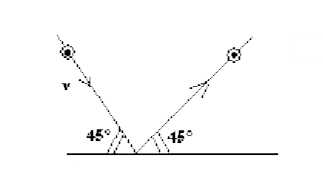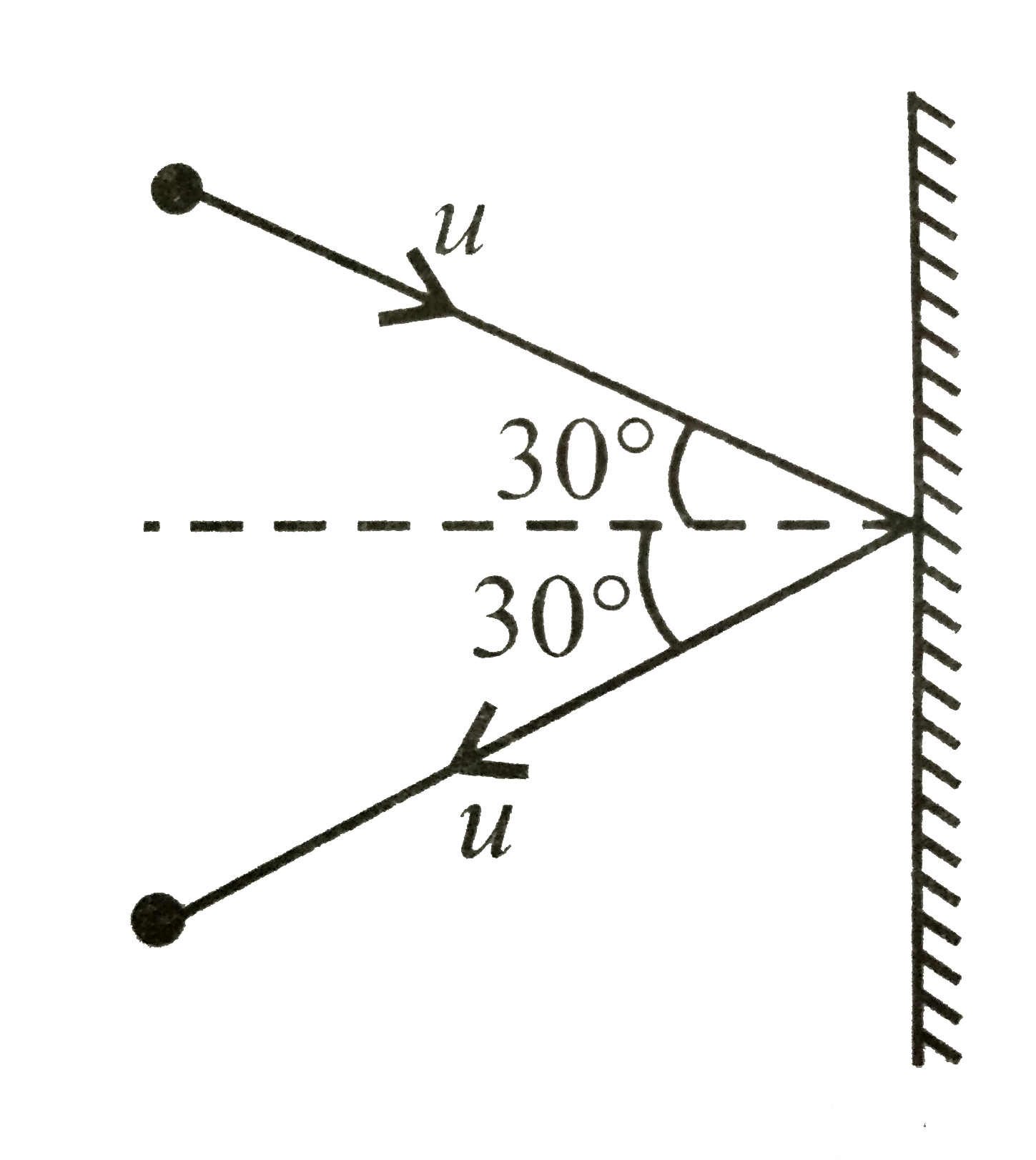STATEMENT - 1 : A ball of mass m is moving towards a batsman at a speed v. The batsman strikes the ball and deflects it by an angle θ without changing its speed. The impulse imparted to the ball is zero.
because
STATEMENT - 2 : Impulse = change in momentum.
Statement - 1 is True, Statement - 2 is True, Statement - 2 is a correct explanation for Statement - 1.
Statement - 1 is True, Statement - 2 is True, Statement - 2 is NOT a correct explanation for statement - 1.
Statement - 1 is True, Statement - 2 is False.
Statement - 1 is False, Statement - 2 is True.
The correct Answer is:D
To solve the problem, we need to analyze the two statements provided and determine their validity based on the principles of physics, particularly the concepts of impulse and momentum.
1. Understanding the Situation:
- A ball of mass m is moving towards a batsman with a speed v.
- The batsman strikes the ball, deflecting it at an angle θ without changing its speed.
2. Defining Impulse:
- Impulse is defined as the change in momentum of an object when a force is applied over a period of time.
- Mathematically, impulse J can be expressed as:
J=Δp=pfinal−pinitial
- Where p is momentum, given by p=mv.
3. Calculating Initial Momentum:
- The initial momentum of the ball before the batsman strikes it is:
pinitial=mv
4. Calculating Final Momentum:
- After being struck, the ball continues to move with the same speed v but in a different direction (deflected by angle θ).
- The final momentum can be expressed as:
p_{\text{final}} = mv' \quad \text{(where v' = v since speed is unchanged)}
- The direction of the momentum changes, but the magnitude remains the same.
5. Change in Momentum:
- Since the speed remains the same but the direction changes, we need to consider the vector nature of momentum.
- The change in momentum can be calculated as:
Δp=pfinal−pinitial
- Since the ball's direction changes, the momentum before and after the strike is not the same, leading to a non-zero change in momentum.
6. Conclusion on Impulse:
- Since there is a change in momentum, the impulse imparted to the ball is not zero.
- Therefore, Statement 1 is false.
7. Validity of Statement 2:
- Statement 2 correctly states that impulse is equal to the change in momentum, which is a fundamental principle in physics. Thus, Statement 2 is true.
Final Conclusion:
- Statement 1 is false, and Statement 2 is true.
- A ball of mass m is moving towards a batsman with a speed v.
- The batsman strikes the ball, deflecting it at an angle θ without changing its speed.
- Impulse is defined as the change in momentum of an object when a force is applied over a period of time.
- Mathematically, impulse J can be expressed as:
J=Δp=pfinal−pinitial
- Where p is momentum, given by p=mv.
- The initial momentum of the ball before the batsman strikes it is:
pinitial=mv
- After being struck, the ball continues to move with the same speed v but in a different direction (deflected by angle θ).
- The final momentum can be expressed as:
p_{\text{final}} = mv' \quad \text{(where v' = v since speed is unchanged)}
- The direction of the momentum changes, but the magnitude remains the same.
- Since the speed remains the same but the direction changes, we need to consider the vector nature of momentum.
- The change in momentum can be calculated as:
Δp=pfinal−pinitial
- Since the ball's direction changes, the momentum before and after the strike is not the same, leading to a non-zero change in momentum.
- Since there is a change in momentum, the impulse imparted to the ball is not zero.
- Therefore, Statement 1 is false.
- Statement 2 correctly states that impulse is equal to the change in momentum, which is a fundamental principle in physics. Thus, Statement 2 is true.
- Statement 1 is false, and Statement 2 is true.
Topper's Solved these Questions
- BOOK - FIITJEECHAPTER - COLLISION EXERCISE - ASSIGNMENT PROBLEMS (OBJECTIVE) Level - II20videos
COLLISION
- BOOK - FIITJEECHAPTER - COLLISION EXERCISE - (COMPREHENSIONS - I)2videos
COLLISION
- BOOK - FIITJEECHAPTER - COLLISION EXERCISE - ASSIGNMENT PROBLEMS (OBJECTIVE) Level - I45videos
COLLISION
- BOOK - FIITJEECHAPTER - AC CIRCUITSEXERCISE - ASSERTION REASONING TYPE1videos
AC CIRCUITS
- BOOK - FIITJEECHAPTER - CURRENT ELECTRICITYEXERCISE - Comprehension -43videos
CURRENT ELECTRICITY
Similar Questions
A body of mass M moving with a speed V collides on a surface at an angle 45 degree without changing its speed the change in momentum of the body will be-
 View Solution
View SolutionA batsman deflects a ball by an angle of 45∘ without changing its initial speed which is equal to 54kmh . What is the impulse imparted to the ball ? ( Mass of the ball is 0.15 kg)
View Solution
Knowledge Check
- Question 1 - Select One
A ball of mass m is moving towards a batsman at a speed v. The batsman strikes the ball and deflects it by an angle θ without changing its speed. The impulse imparted to the ball is given by
AmvcosθBmvsinθC2mvcos(θ2)D2mvsin(θ2) - Question 2 - Select One or More
Aparticle moves with a speed v changes direction by an angle θ, without change in speed.
Athe change in the magnitude in velocity is zeroBthe change in the magnitude fo its velocity is 2vsinθ/2Cthe magnitude of change in velcoity is 2vsinθ/2Dthe magnitude of change in velocity is v(1−cosθ) - Question 3 - Select One or More
A particle moving with a speed v changes direction by an angle θ, without change in speed.
AThe change in the magnitude of its velocity is zeroBThe change in the magnitude of its velocity is 2vsin(θ/2)CThe magnitude of the change in its velocity is 2vsin(θ/2)DThe magnitude of the change in its velocity is v(1−cosθ)
A batsman deflects a ball by an angle of 45∘ without changing its initial speed which is equal to 54kmh . What is the impulse imparted to the ball ? ( Mass of the ball is 0.15 kg)
View SolutionA ball of mass m strikes a rigid walJ with speed u and rebounds with the same speed. The impulse imparted to the ball by the wall is
 View Solution
View SolutionA ball of mass m strikes a rigid walJ with speed u and rebounds with the same speed. The impulse imparted to the ball by the wall is
View SolutionA ball of mass 'm' strikes a rigid wall with speed 'u' and rebounds with the same speed. The impulse imparted to the ball by the wall is
View SolutionA batsman hits back a ball of mass 0.2 kg, straight in the direction of the bowler without chaning its initial speed of 6 m/s. What is the impulse impated to the ball?
View Solution

